THE EGYPTIAN SOCIETY OF SOUTH AFRICA
Iziko Museums
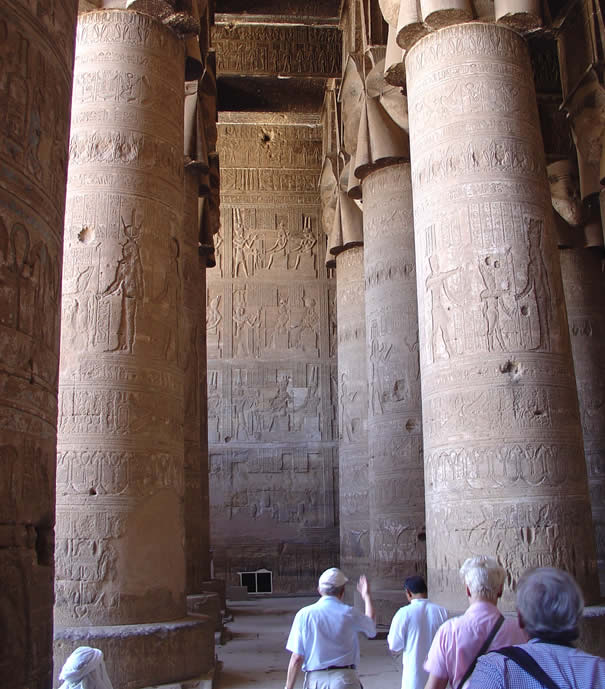
IZIKO MUSEUMS OF SOUTH AFRICA
Corner Adderley & Wale Streets, Cape Town
Telephone +27 (0)21 460 8242
Iziko Slave Lodge opening times:
Mondays to Saturdays 09:00-17:00
Closed Sundays, Workers’ Day and Christmas Day
Acknowledgements for KEMET
The Iziko Museums acknowledges TESSA for its contribution towards the KEMET AR game and for continued support of the Egyptian collection.
The KEMET exhibition was designed by Amy Sephton (Iziko exhibitions designer) and Nosingiphile Mazibuko (Iziko 2D exhibitions designer).
Dr. Jessica Nitschke is acknowledged for her scholarly input towards the exhibition upgrade project. It was Dr. Nitschke’s idea to name the exhibition KEMET, the name ancient Egyptians used for their country.
Besides Dr. Nitschke, the following individuals contributed towards the development of exhibition texts – Anlen Boshoff (retired curator of Egyptology and Research Associate at the Iziko Museums); Jay van den Berg; Brittany Leatherman and Nancy Lizibeth Lopez (interns, Michigan State University, USA); and Amy Sephton (Iziko exhibitions designer).
The academic team who researched the mummy bird is acknowledged as well – Prof. Izak Cornelius (Department of Ancient Studies, Stellenbosch University); Dr. Ruhan Slabbert (Research Associate affiliated to the same department); Prof. Anton du Plessis of the CT Scanner Facility, Stellenbosch University; and Prof. Salima Ikram of the American University in Cairo, Egypt.
Text provided by:
Esther Esmyol (Curator at Iziko Museums of South Africa, eesmyole@iziko.org.za)
External scholars and advisors Dr. Jessica Nitschke and Anlen Boshoff
For more information:
See link to Egyptian mini-website at end of Iziko website opening page www.iziko.org.za and https://www.iziko.org.za/collections/ancient-and-classical-cultures
*Re Winifred Newberry see https://trowelblazers.com/winifred-brunton/
Egyptian Collection at the Iziko Museums of South Africa
The Iziko Museums of South Africa holds collections covering areas of social history, art and natural history, and hosts exhibitions at a number of museums in Cape Town. The collections of the former South African Cultural History Museum (SACHM) today form part of the Iziko Museums. The Egyptian collection is currently on exhibition at the Iziko Slave Lodge, at the top of Adderley Street in Cape Town.
Iziko’s Egyptian collection
The Iziko Museums collection includes approximately 400 artefacts from ancient Egypt – many of which became part of Iziko’s collection over a century ago. A majority of the artefacts were acquired through donations in the early 20th century by the British School of Archaeology in Egypt, the Egypt Exploration Fund, and British Egyptologists Sir Flinders Petrie and his student Guy Brunton. The rest of the collection comprises donations from South African collectors and the occasional purchase, mostly acquired in the mid 20th century. The collection is small but comprehensive, incorporating artefacts from the Predynastic to Roman times. Approximately 90 objects are currently on public display.
The majority of artefacts in Iziko’s collection are from excavations carried out by British archaeologist and Egyptologist Sir William Matthew Flinders Petrie (1853 – 1942).
Sir Flinders Petrie made valuable contributions to Egyptian archaeology through his discoveries and methods used. In the late 19th century, most early archaeologists had little scientific expertise; their goal was to find beautiful objects rather than carry out controlled excavations where the context of the found object was as important as the object itself. However, Petrie was much more thorough and careful in his excavations, and took detailed notes and measurements. Paying as much attention to small and ordinary objects as he did to the beautiful and impressive, Petrie paved the way for a better understanding of the lives of everyday Egyptians. He is also credited with the discovery of Predynastic and Early Dynastic Egypt and with the creation of a scientific archaeological method called ‘sequence dating’.
Of the various objects held by Iziko, the most notable group is the assemblage of late Predynastic and Early Dynastic artefacts from Petrie’s excavations at Kafr-Tarkhan (situated south of Cairo). Petrie’s excavations here were done over two seasons: from 1911 to 1912, and from 1912 to 1913. Over 2 000 ancient grave sites were excavated at Kafr-Tarkhan – and most found artefacts date back to Naqada III and Dynasty 1 (c. 3325 – 2667 BCE). During this time, Egypt was undergoing a transition from different autonomous regions to a unified state – and the site of Kafr-Tarkhan provided key evidence for creating a chronological framework to understand this transition, including inscriptions revealing the identity of some of Egypt’s earliest kings. Kafr-Tarkhan has also provided the earliest evidence, so far, for the usage of the hieratic script (a cursive version of hieroglyphs).
The Kafr-Tarkhan collection includes ceramic and stone vessels, linen, basketry, fragments of wooden furniture, cosmetic accessories such as slate palettes and spoons, fragments of stone, metal tools, beads and bone bangles.
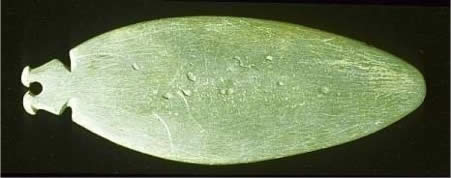
Slate palette. Excavated by Sir Flinders Petrie at Kafr-Tarkhan. Dynasty 1. Iziko collection SACHM1895.
Sir Flinders Petrie had a South African connection. His paternal grandparents, Margaret Mitten and William Petrie, resided at the Cape Colony for about ten years from 1829. One of their sons, William Petrie Junior, married Anne Flinders, daughter of Ann Chappell and Captain Matthew Flinders (1774-1814), the explorer and cartographer of Australia. Their only child, William Matthew Flinders Petrie was born on 3rd June 1853.
Another South African connection is that of Winifred Brunton (née Newberry; 1880 – 1959) and her husband Guy Brunton (1878 – 1948). Winifred Newberry* was the daughter of a wealthy South African miner, and she married Guy Brunton in 1906 when the latter was living in South Africa. Both Guy and Winnie studied Egyptology at University College, London, and worked closely with Petrie, starting with his excavations at the site of Lahun in 1912. The couple continued to excavate at many sites together over the years, as indicated by Petrie’s own diaries and the acknowledgments in publication volumes, although only Guy Brunton’s name appears on the publications. Winifred Brunton also became an accomplished artist and is best known for her portraits of ancient Egyptian historical figures. A small number of artefacts excavated by the Bruntons in Middle Egypt, dated to the Predynastic to the Coptic period, were donated to the Egyptian collection in Cape Town in 1929.
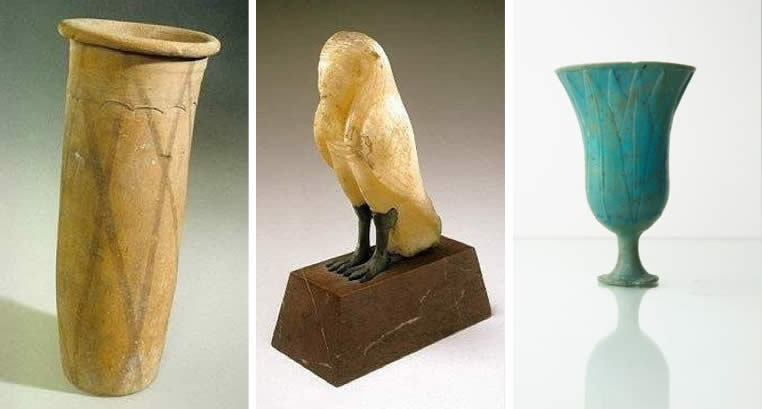
Left: Pottery jar. Excavated by Sir Flinders Petrie at Kafr-Tarkhan. Predynastic. Iziko collection SACHM1844.
Middle: Alabaster Ba-bird with modern bronze legs. Excavated by Guy Brunton at Thebes. 18th Dynasty. Iziko collection SACHM2938.
Right: Lotus flower cup, blue faience. Iziko collection SACHM1722.
The Egyptian collection forms an important part of the museum’s holdings, and has been very popular through the years, not only with researchers and academics but also with school-going learners as the ancient Egyptian culture is a subject of study in the South African school curriculum.
The ancient collections at the Iziko Museums also hold a number of artefacts from the ancient Near East (pottery, cylinder seals, cuneiform tablets), Roman items and a small but excellent collection of Greek vases (black-on-red and red-on-black).
KEMET: Life in ancient Egypt
On 1 December 2018 the Iziko Museums opened a redesigned and upgraded version of the Egyptian exhibition called KEMET: Life in ancient Egypt at the Iziko Slave Lodge Museum.
Ancient Egyptians called their country Kemet (kmt), meaning ‘black land’, referring to the fertile black soils of the Nile flood plains, as opposed to the ‘red land’ of the desert. The word ‘Egypt’ comes from the ancient Greek name Aiguptos, which in turn came from an Egyptian name Hikuptah, meaning the ‘house of the god Ptah’. Hikuptah was one of the ancient names of Memphis, a major city in ancient Egypt.
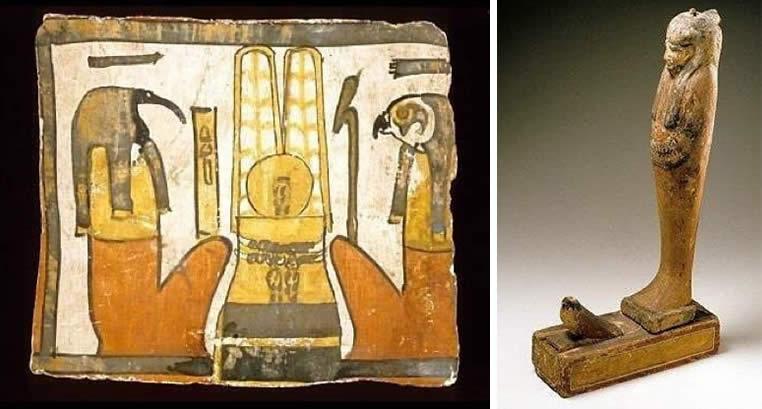
Left: Painted section of a linen canvas mummy case. Amun’s head-dress with tall plumes and sun-disc at the centre, flanked by Thoth (left) and Horus (right). 20th Dynasty. Iziko collection SACHM1598.
Right: Wooden statue of the god Ptah-Sokar-Osiris. Combining characteristics of Ptah (creation), Sokar (death as metamorphosis), and Osiris (rebirth), this deity symbolized the whole cycle of regeneration in a single entity. Probably Ptolemaic period. Iziko collection SACHM1725.
KEMET: Life in ancient Egypt focusses on those aspects that made the ancient Egyptians so remarkable, and their contributions to the modern world. Various topics are covered in the KEMET exhibition texts and displays, such as the importance of the Nile River in the lives of the Egyptians, the contribution that the ancient Egyptians made with regards to writing systems, science and technology, as well as aspects of ancient Egyptian life such as religion, the gods they believed in, ways of living, and the importance of the afterlife.
A new addition to the redesigned KEMET exhibition is an Augmented Reality (AR) game which was created in partnership with students from the Game Graphics & Multimedia Entertainment department at the Friends of Design – Academy of Digital Arts in Cape Town. The AR game provides alternative and interesting ways of learning. It is a fun and interactive opportunity for learners and visitors to get to know more about life in ancient Egypt by following the story of an ordinary Egyptian, and what happened when he passes away to enter the afterlife.
The game weaves in various aspects of the ancient Egyptian culture, religion, funerary practices and how to live life to enter the afterlife. Links are made to the artefacts on exhibition, enhancing an understanding and appreciation of ancient African societies.
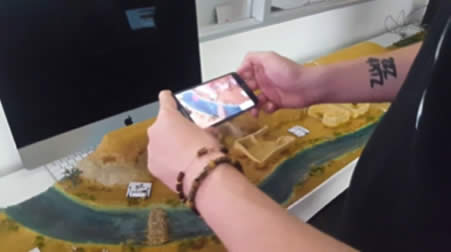
Developing the KEMET AR game. Photograph courtesy Friends of Design – Academy of Digital Arts.
TESSA kindly assisted the Iziko Museums in the acquisition of equipment central to the operation of the AR game.
Modern technology has also in the past greatly enhanced our knowledge about the artefacts in the ancient Egyptian collection, such as when sophisticated digital 3D X-ray imaging was done on the mummified animals in the collection. The scanning, analysis and research were carried out by scientists and researchers from the Stellenbosch University. The findings made known in 2015, yielded a world first, as it was discovered that an ancient Egyptian bird mummy in the museum collection carries the remains of at least two house mice and a small sparrow in its stomach. This was the first evidence found to point to the mass breeding of raptor birds as offerings to gods and deities in ancient Egypt. Based on morphology, limb measurements and beak shape, the researchers established that the mummy bird was a European kestrel (Falco tinnunculus).
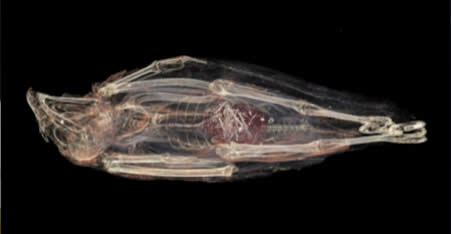
A 3D image of the mummified kestrel in the Iziko collection (SACHM2572) showing the tail of a young house mouse extending through the bird’s esophagus. Photograph by Prof. Izak Cornelius © Stellenbosch University. The mummy bird is on exhibition in KEMET.
